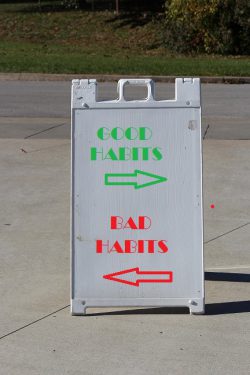Habits are easy to form. Just look at everything you do every day on “auto pilot.” Some of our habits are good, healthy ones – others, not so much.
Habits can be formed by sheer repetition of actions. They can also be formed when the brain’s reward center is triggered by the release of dopamine. Actions or events we find enjoyable – including activities like smoking, overeating, gambling and even compulsive use of computers and social media – trigger dopamine release.
Both types of habits can become hard-wired in the brain. That makes them automatic, so we don’t have to consciously think about them.
Forming Habits
The three-part “habit loop” consists of a cue, a behavior and a reward. Repeating an action consistently, in the same context, over time produces a habit.
During the “initiation phase” the behavior and the context in which it will be performed are determined. Automaticity is achieved in the “learning phase” where the behavior is repeated in the proper context, strengthening the context-behavior association. The final “stability phase” is reached when the habit has formed and plateaued in strength so it can persist with minimal thought and effort.
Neuroscientists have identified the role of the brain’s basal ganglia (also involved in memories, emotions and pattern recognition) in habit-making. Decisions are made elsewhere in the brain – in the prefrontal cortex. But when a behavior becomes automatic, the decision-making part of the brain bows out.
Many people have heard it takes 21 days to establish a habit; this idea was proposed in the 1960’s and based on observation. More recently, research at University College London has found a curved relationship between practice and automaticity. The length of time it takes to form a habit varies widely, depending on the habit you’re trying to form and how dedicated you are. These researchers found that, on average, automaticity peaks at about 66 days. So developing a simple habit requires about 2 months of daily practice. Skipping a single day doesn’t change that much, but it is the early days of repetition that really help the process along. Once automaticity has peaked, that behavior is as much of a “habit” as it’s ever going to be.
Breaking Habits
Habits can be changed by conscious decision-making and willpower. But those habits that release dopamine are harder to change because the brain recognizes a reward for them. The dopamine strengthens the habit, and when we’re not engaged in that behavior the brain still yearns for the dopamine; that results in cravings.
Dr. Roy Baumeister, a psychologist at Florida State University, has found that “self-control is like a muscle. Once you’ve exerted some self-control, like a muscle, it gets tired.” In that state, willpower is not as effective. His research has shown, though, that willpower can be strengthened by regularly practicing self-control (this is how keeping a food diary helps reduce habitual overeating).
Dr. Nora Volkow, director of NIH’s National Institute on Drug Abuse notes there is more than one way to break a bad habit:
- Focus on being more aware of unhealthy habits and develop ways to counteract them. If an unhealthy habit is associated with certain activities or places, avoid those temptations.
- Use visualization to practice – mentally – behaving in a healthy rather than an unhealthy manner.
- Replace unhealthy habits with healthy ones. The first-learned habit in this case does not go away (it’s impossible to form a habit for not doing something). Both the new and the old remain in the brain. Strengthening the later-learned behavior can suppress the first-learned one.
- Ask family, friends and co-workers for support in your efforts. Set small, achievable goals (simple actions become habit more easily than complex ones). And reward yourself for small victories.
Taking a vacation is a proven way to successfully break an old habit and form new behavior patterns. Automated behaviors will be performed the same way every time if they are in the same environment. When you take a vacation, you change the environment. With none of the usual cues and rewards available, behavior can be changed.
It’s never too late to break a habit. The easiest way to do that is by understanding the “habit loop” of cue, behavior and reward and finding a way to interrupt that loop.
References:
Gardner, B., Lally, P., & Wardle, J. (2012). Making health habitual: the psychology of ‘habit-formation’ and general practice. br j gen pract, 62(605), 664-666. doi:10.3399/bjgp12x659466
www.newsinhealth.nih.gov/issue/Jan2012/feature1
www.npr.org/2012/03/05/147192599/habits-how-they-form-and-how-to-break-them
www.spring.org.uk/2009/09/how-long-to-form-a-habit.php
